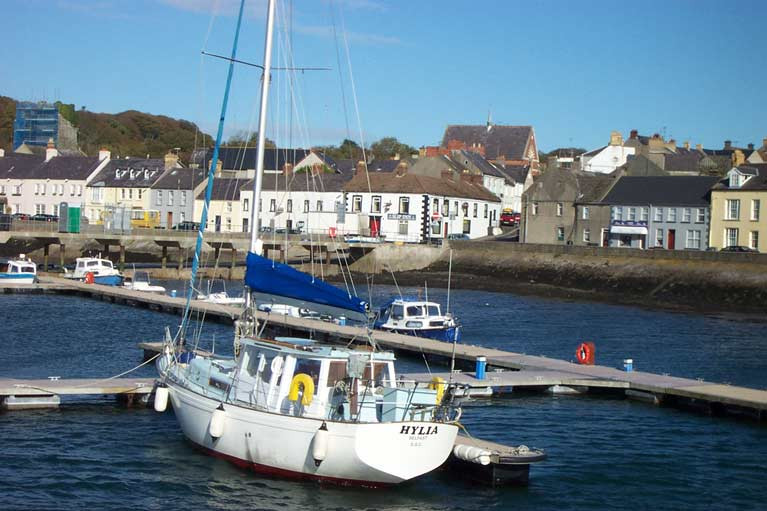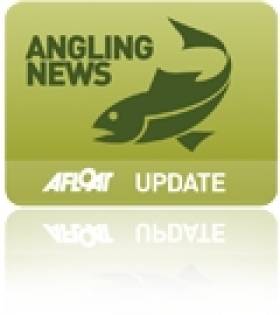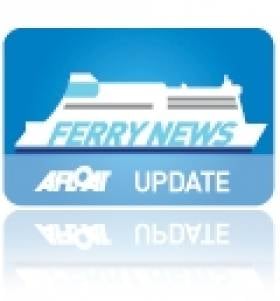Displaying items by tag: Carrickfergus
Long-Standing Member of East Belfast Yacht Club Dies After Boat Capsizes Off Carrickfergus
RTÉ News reports that a 94-year-old man has died in what the PSNI are calling a “tragic growing incident” after his boat capsized in Belfast Lough in Northern Ireland on Sunday (28 August).
Jim Allen, a long-standing member of East Belfast Yacht Club, had been with a friend on a yacht that launched from the club on Sunday afternoon when he made a Mayday call around 3pm reporting that the vessel was taking on water.
It’s understood that the yacht quickly capsized about 2.4km off Carrickfergus, near Greenland. Allen’s friend, a man in his 70s, survived the incident and was treated by emergency services at the scene.
RTÉ News has more on the story HERE.
Antrim Marinas & Harbours to Be Dredged Over Winter
Two marinas and two harbours in the Mid and East Antrim Council area will be dredged over the coming winter and following Spring. They are Carnlough Harbour and Glenarm Marina on the Antrim Coast Road and Carrickfergus Marina and Harbour on the north shore of Belfast Lough.
Carnlough Harbour will be closed from Monday 1st November until Friday 19th November 2021 and Carrickfergus Harbour from Thursday 24th March 2022 until Tuesday 17th May 2022.
 Carnlough Harbour
Carnlough Harbour
Glenarm Marina dates are from Friday 19th November until Thursday 16th December 2021 and Carrickfergus Marina will be dredged from Thursday 16th December 2021 until Thursday 24th March 2022. The marinas and harbours were due to be dredged as some areas are now below the minimum depths as per hydrographic surveys.
 Glenarm Marina Photo: Tourism NI
Glenarm Marina Photo: Tourism NI
The Council has warned that these dates are subject to movement based on contractual changes and effects of weather. A further notice to mariners will be issued if the programme changes.
The largest number of boats affected will be those berthed in Carrickfergus which has a capacity of 300. It was dredged in 2015. Glenarm has recently had extra berths added to make the total 50. Carnlough lies 16 miles south of Fair Head and is used mainly by pleasure boats and small fishing vessels.
 Carrickfergus Harbour Photo: Rossographer
Carrickfergus Harbour Photo: Rossographer
The contractors are the 192-year-old Charles Brand Ltd company based in Sydenham, Belfast and Foyle and Marine Engineering JV with HQ in Claudy, Co. Londonderry.
Karena Catterson, Maritime Development Officer at Carrickfergus Marina stated that Berth Holders were given various options for the period of dredging:
- They can lift their boat out and receive a full refund for their berthing during the dredging period and Council will pay 50% of their lift in and out costs.
- They can relocate to another marina of their choice for which Council will pay full costs. In cases where berthing fees are cheaper, the difference in costs will be refunded.
- They can remain in the marina and receive a 30% discount on their fees, and where it can be facilitated access will be granted for emergencies.
- Liveaboards will remain in the marina as normal.
Some boat owners have arranged to move to Bangor Marina where Kevin Baird, Harbour Master and Marina Manager, is making plans; “We are in the planning/berth allocation stage, and we know that some of those who have booked in with us will be arriving early. Hopefully, all goes to plan, and the weather stays calm to allow barges to dump at the designated spoil site”.
Carrickfergus Swimmers Benefit from Repairs to Access Steps
Sea swimmers in the Carrickfergus area now have safer access to the shore after the repair of steps and railings southeast of the Co Antrim town’s marina on Belfast Lough.
According to the Carrick Times, local bathers has raised the “dilapidated state of disrepair of the steps and railings at Rhanbuoy” with MLA Roy Beggs, who took the matter to Mid and East Antrim Borough Council.
The Carrick Times has more on the story HERE.
Carrickfergus Sailing Club in Northern Ireland looks forward to welcoming 500 competitors across its scheduled summer series of racing, as The News Letter reports.
August will be an especially busy month for the Co Antrim club, with its home regatta on 28 August following the Topper Northerns on 21-22 August and the RS Northerns the weekend prior.
And the activity will continue into September with the RYA Youth Championships and the rescheduled J2 Northerns both coming to the north shore of Belfast Lough.
The News Letter has more on the story HERE.
The situation around the opening of marinas and harbours in Northern Ireland in COVID-19 appears fluid but the latest news is good for those wanting to relax, sail and visit.
Bangor Harbour Master Kevin Baird says that Bangor, Carrickfergus, and Glenarm marinas and harbours are open to visitors but for short stay only – no overnighting.
Also open to all are the Ards and North Down harbours but the Copeland Islands off Donaghadee are completely closed. Marinas and harbours in the Newry and Mourne Council areas are open on the same basis – short stay only.
Belfast Harbour Marina has confirmed that it is open for residents only.
Going north all the Causeway Coast and Glens Marinas and Harbours are now open but only to residents, with the exception of Rathlin Island. It will remain closed for in the short term to all vessels, including visitors. John Morton, Ballycastle Harbour Master, has clarified, “We are not open for any visiting vessels at this time, only resident ones. This will be reviewed over the coming weeks”.
In Strangford Lough, Portaferry Marina has been open for residents and visitors since 25th May but there is no news on Strangford town pontoon or on Foyle Marina in Derry.
The current Foyle Port website posts a Notice to Mariners stating that Foyle Port Marina is closed to visiting vessels and crafts. A further notice will be issued when the marina has re-opened to all.
On the subject of crews, Kevin Baird says, “ Our understanding is that groups of up to six people who do not share a household can meet up outdoors and onboard boats while maintaining social distancing, i.e. two metres”.
RS Elite Irish National Title Stays on Belfast Lough
The RS Elite Irish Nationals has just taken place, hosted this year by Carrickfergus Sailing Club. With brisk conditions and a lumpy sea, Holywood man Simon Brien Championship win was an impressive affair.
There was stiff competition from Stephen Polly, and Mark Brien (Brother of Simon) also Solent boat Mike McIntyre, but Simon on board “KIN” (RNIYC) along with his daughter Tiffney and Oli Loughead had a very impressive 5 wins and one 3rd leaving Kin with a perfect score of 5 after discard. Stephen Polly’s “Storm” (RUYC) finished 3rd overall with John Gunning and David Kelso on board. Hayling Island boat “Foudafafa” helmed by Mike McIntyre tacking second overall.
Carrick ran a very impressive Event, 3 races each day with race management by Ballyholme’s Robin Gray, great social and a taxi service across the Lough to and from RNIYC. Carrick celebrating its 150 years did it in style!
The Irish Elite Nationals was just a warm up for the fleet as the attention turns this week to Strangford Lough where the UK Elite Nationals are being hosted. A strong English representation is expected and competition will be very stiff. For this Event “Kin” will be helmed by Tiff Brien who has narrowly missed out on winning this event in the past, that said some of the Strangford Elites with local knowledge will not make it easy for her. Also Ryan Wilson on “Eclipse” could show good form at this Championship. Wind is expected to be lighter this week.
#sb20 – The sb20 fleet assembled in Carrickfergus last weekend for their Northern Championship for what was supposed to be the opening of the new club house writes Ronan Downing. Unfortunately "Health & Safety" hadn't signed off on occupation or the club thought better of it considering the fleet had the last regatta at the old club before it burnt down. With an entry list comprising numerous national champions, commodore cup sailors and an Olympian the competition was always going to be fierce.
Results are available to download below as a PNG file.
The conditions on Saturday didn't live up to expectations with the wind completely shutting down at the second leeward mark of race one robbing Who's The Boss (Mel Collins, Killian Collins and Luca) of a comfortable race victory. This lead was hard fought for after Bad (Stefan Hyde, Gerry Dowling, Jimmy Dowling) managed to tie themselves to the spreader mark TWICE giving away a 2 minute lead. Sailing for the day was cancelled after much waiting around in very cold, dreary and wet conditions. The fleet retired to the bar in the boat shed where we were treated to a barbecue. The new club house might not have been ready but the hospitality made everyone feel welcome.
For day 2 the sun came out and the breeze was up building from 15 knots in the lulls to just shy of 30 in the gusts by the end of the day. After a general recall the fleet got away under the u flag off a square line. Over the next 3 legs the lead changed several times with Who's the boss leading around the second weather mark. The downwind legs were full planing on both gybes making the leeward gate arrive rapidly. With tidier drops Bad and ManaMana (Graeme Grant, Ronan Downing, Tara Flood) took the lead. A match race to the finish ensued which opened the door for Dinghy Supplies ( Daragh Sheridan, Shane Murphy, John Phelan) who had stormed down the last downwind leg. A photo finish at the line saw Dinghy Supplies take the win from Bad and ManaMana with Ridgefence (Peter Kennedy, Andrew Vaughan, Stephen Kane) taking fourth from Who's the Boss.
Race 2 saw Who's the boss take the lead on the first beat closely followed by a large pack. This time the Cork/ Italian crew weren't going to let it slip away and extended on every leg winning by a substantial margin. The race for second was one by Ruby Blue (Aidan O Connell, Brian Reilly, Alan Daly) from Dinghy Supplies and BomChickaWhaWha (John O Driscoll, Robert O Donohoe, Edward Cooke). Ridgefence took fifth with ManaMana in sixth. This put Dinghy Supplies out in front of Who's The Boss by a point. With the top sixth all within 3 points.
Race 3 got off first time of asking on another square line. ManaMana rounded the weather mark first closely following by BomChickaWhaWha, WhosThe Boss and RidgeFence. After a slow kite hoist at the second weather mark by ManaMana, BomChickaWhaWha took the lead and the win followed by Manamana, Ridgefence and Who's the Boss with Bad in fifth. This left the scoring all tied between Manamana and BomChickaWhaWha in second with Who's The Boss 1 point ahead in first.
With all to play for in race 4 the breeze really filled in as the fleet got off another clean start on a square line. ManaMana lead out to the right side of the course after starting second row at the committee boat. This gave ManaMana a 6 boat length lead at the first weather mark with what appeared to be the entire fleet arriving together behind. ManaMana extended on the first downwind with Ridgefence in second breaking away from the following pack. After Ridgefence broached and ditched their kite at the leeward mark ManaMana now had a substantial lead and loose covered the entire fleet up the next beat. BomChickaWhaWha made the best effort to next break away from the following pack by playing the right hand side of the course. With many wipe outs on the next downwind including a wayward kicker on the lead boat during a gybe, survival proved the better part of valour. ManaMana managed to hold onto first with BomChickaWhaWha taking second and Shark Bait (Darren Martin, Simon Murray, Roger Pannell) having their best race of the day with a third.
Who's the boss retired from the last race after being involved in a small collision which left the overall results ManaMana first on 6 points, BomChickaWhaWha second on 7 points and Dinghy Supplies taking third from Who's The Boss on count back both on 10 points. Ruby Blue took fifth from Ridgefence on count back tied on 12 points. The silver fleet was won by Bad with Shark Bait in second and www.yachtsmarine.ie (Davey Taylor, Trevor D'Arcy, Lisa Neary) in third.
The class would like to make a special mention about the Race Officer Robin Gray. The R.O. did an exceptional job on Sunday getting four fantastic races in on one day to complete the regatta.
#Angling - The World Youth Fly Fishing Championship is coming to Ireland's border region next month.
And as the Carrick Times reports, Carrickfergus in Co Antrim is looking forward to hosting part of the event at the Woodford Fly Fishery.
What's more, local lad and Woodford member Darren Crawford will be among the all-Ireland fly fishing squad vying for the international title at the event, co-sponsored by the Loughs Agency and Inland Fisheries Ireland.
Rivers and lakes hosting the competition are spread over the counties of Antrim, Louth, Monaghan, Meath and Tyrone.
In other inland fisheries news, Galway Bay FM reports that testing carried out after a fish kill in Loughrea Lake last month found no evidence of any bacterial or viral outbreak.
The cause of the incident that killed 100 perch in the lake are still unclear, though stresses connected with the spawning season are a distinct possibility.
#FERRY NEWS - The captain of the cargo ship Union Moon, who was arrested after his vessel collided with a passenger ferry in Belfast Lough, has been charged with 'excess alcohol by the master of a ship'.
BBC News reports that the 55-year-old was set to appear in court today, following his arrest yesterday.
No one was injured in the incident on Wednesday, when the Union Moon collided with the Stena Feronia close to the Fairway buoy between Carrickfergus and Helen's Bay. Both vessels were substantially damaged.
The cargo ship, which was carrying 2,000 tonnes of aggregate, was brought back to Belfast. Philip McNamara of the Donaghdee lifeboat confirmed that a large section of her bow was missing.
Meanwhile, engineers from Stena Irish Sea are assessing the damage to their vessel to determine how long it will be out of service. The Stena Feronia sails the route from Belfast to Birkenhead in Merseyside.
The Maritime and Coastguard Agency, the Marine Accident Investigation Branch and the PSNI are all involved in the investigation.
BBC News has more on the story HERE.
- Ferry news
- collision
- Belfast Lough
- cargo ship
- Union Moon
- captain
- charged
- drink
- excess alcohol
- ferry
- Stena Feronia
- Birkenhead
- Merseyside
- court
- Fairway buoy
- Carrickfergus
- Helen's Bay
- Philip McNamara
- Donaghdee
- Lifeboat
- Stena Irish Sea
- Maritime and Coastguard Agency
- Marine Accident Investigation Branch
- psni
Vessels Collide in Belfast Lough
#FERRY NEWS – A passenger ferry and cargo vessel collided in Belfast Lough last night and there are no reports of any injuries. The incident happened close to the Fairway buoy about a mile and a half from shore between Carrickfergus and Helen's Bay, according to BBC News.
It is understood that the ferry Stena Feronia (1997/21,856grt) has now docked at the Stena terminal. The other vessel - a cargo ship, the Union Moon (1985/1,543grt)- was accompanied by the coastguard as it was brought back to Belfast.
The ferry was on its way from Birkenhead, Merseyside, to Belfast when the collision happened, to read more on this story click HERE.



































































